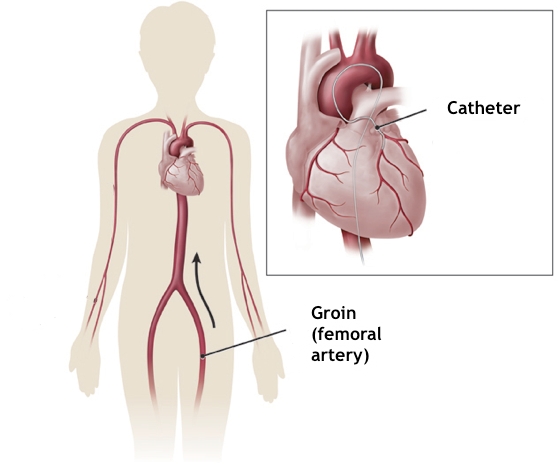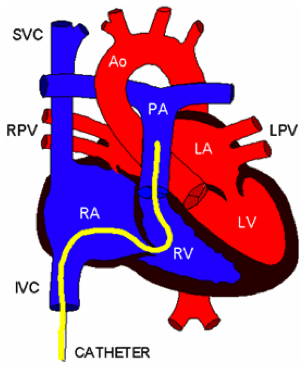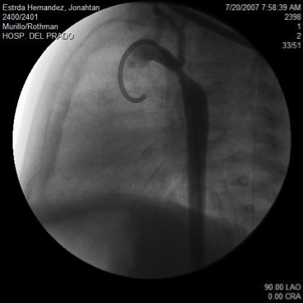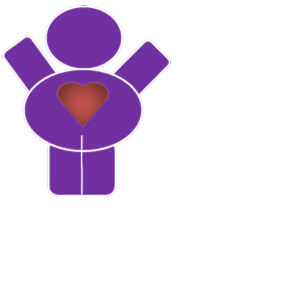Cardiac Catheterization
A procedure that involves puncturing an artery or vein, usually located in the groin, so that a small, long, flexible tube (catheter) can be guided into the heart and major vessels around the heart.
The catheter is moved through the heart with the aid of fluoroscopy (x-ray machine). This is usually performed to help in providing a diagnosis of heart problems.
Interventional catheterization is a type of cardiac catheterization where actual treatments can be performed by use of specialized catheters.
These specialized catheters include balloon catheters that can open up narrowed valves or arteries and also catheters where devices can be deployed which can close extra vessels or certain "holes" in the heart.
Why is catheterization helpful?
With cardiac catheterization, pressure measurements and blood samples can be obtained from the various cardiac chambers and blood vessels around the heart allowing calculations of detailed information about the heart's function.
X-ray dye can also be injected through the catheters giving pictures of structures in and around the heart.
What will happen on the day of the procedure?
You will meet with the doctor prior to the day of the procedure if necessary. The child will be examined and a nurse will obtain vital signs.
Your child will be admitted to the Recovery Room of the Cardiac Catheterization Laboratory, where you will meet the doctors performing the procedure. They will explain the benefits and the risks of the procedure so you will be able to give consent for the procedure.

The child will need certain tests including a chest X-ray, an electrocardiogram (EKG), and some blood tests. Your child will be given some medication to make him / her sleepy before being transported to the catheterization laboratory.
After the catheterization, your child will be taken to the recovery room where he / she will be observed for 4 hours.
Depending on the type of intervention performed and how well your child recovers, a longer period of observation in the Same Day Surgery unit or overnight admission to the cardiac unit may be required.
Who performs the procedure?
The interventional catheterization is only performed after careful cardiac evaluation by a pediatric cardiologist; therefore, only a pediatric cardiologist can order this procedure.
When and how often is the treatment performed?
The timing of the procedure is dependent on the type of heart problem your child has. Most procedures only need to be performed once, but some may need a second procedure later in the child's life.
Is cardiac catheterization painful?
A child is given sedation before the procedure. For some procedures, general anesthesia may be recommended.
Generally, the only pain the child may feel is the injection of local anesthetic (similar to novocaine given by the dentist) that is used to numb the area in the groin where the catheters will be inserted.
Intermittent additional sedation is given during the catheterization, as necessary, to keep the child comfortable.
The child may have some bruising in the groin area where the catheters were inserted and may be sore for a couple of days. This generally can be treated with acetaminophen (such as Tylenol").
Is cardiac catheterization risky?
The procedures are generally low risk, with incidence of minor complications under 5 percent. Each type of interventional catheterization procedure has its own unique risks and complications and can be discussed with the doctor performing the catheterization.

